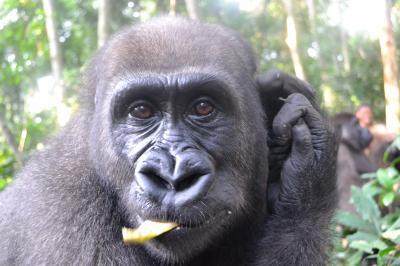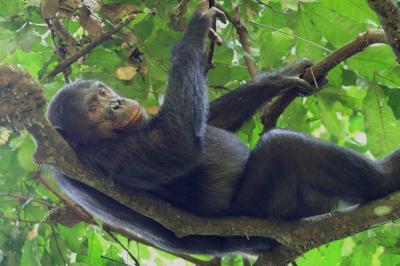PHILADELPHIA - An international team of scientists has traced the origin of Plasmodium vivax, the second-worst malaria parasite of humans, to Africa, according to a study published this week in Nature Communications. Until recently, the closest genetic relatives of human P. vivax were found only in Asian macaques, leading researchers to believe that P. vivax originated in Asia.
The study, led by researchers from the Perelman School of Medicine at the University of Pennsylvania, found that wild-living apes in central Africa are widely infected with parasites that, genetically, are nearly identical to human P. vivax.
This finding overturns the dogma that P. vivax originated in Asia, despite being most prevalent in humans there now, and also solves other vexing questions about P. vivax infection: how a mutation conferring resistance to P. vivax occurs at high frequency in the very region where this parasite seems absent and how travelers returning from regions where almost all humans lack the receptor for P. vivax can be infected with this parasite.
Of Ape and Human Parasites
Members of the labs of Beatrice Hahn, MD, and George Shaw, MD, PhD, both professors of Medicine and Microbiology at Penn, in collaboration with Paul Sharp, PhD, an evolutionary biologist from the University of Edinburgh, and Martine Peeters, PhD, a microbiologist from the Institut de Recherche pour le Développement and the University of Montpellier, tested over 5,000 ape fecal samples from dozens of field stations and sanctuaries in Africa for P. vivax DNA. They found P. vivax-like sequences in chimpanzees, in western and eastern gorillas, but not in bonobos. Ape P. vivax was highly prevalent in wild communities, exhibiting infection rates consistent with stable transmission of the parasite within the wild apes.
Ape P. vivax infects both gorillas and chimpanzees, unlike the ape precursor of P. falciparum, the deadliest human malaria parasite, which only infects gorillas. The origin of P. falciparum in gorillas was discovered several years ago by the same international group of investigators. The team continued its widespread screen of malaria parasite DNA in wild-living primates, and noted that P. vivax was also endemic in gorillas and chimpanzees in central Africa.
To examine the evolutionary relationships between ape and human parasites, the team generated parasite DNA sequences from wild and sanctuary apes, as well as from a global sampling of human P. vivax infections. They constructed a family tree of the sequences and found that ape and human parasites were very closely related. But ape parasites were more diverse than the human parasites and did not group according to their host species. In contrast, the human parasites formed a single lineage that fell within the branches of ape parasite sequences.

This is a photo of Kinguema, an orphaned juvenile male gorilla being reintroduced into the wild in the Congo by the Aspinall Foundation.
(Photo Credit: Peter D. Walsh)
From these evolutionary relationships, the team concluded that P. vivax is of African -- not Asian -- origin, and that all existing human P. vivax parasites evolved from a single ancestor that spread out of Africa. The high prevalence of P. vivax in wild-living apes, along with the recent finding of ape P. vivax in a European traveler, indicates the existence of a substantial natural reservoir of P. vivax in Africa.
Solving a Paradox
Of the five Plasmodium species known to cause malaria in humans, P. vivax is the most widespread. Although highly prevalent in Asia and Latin America, P. vivax was thought to be absent from west and central Africa due to a mutation that causes the Duffy-negative phenotype in most indigenous African people.P. vivax parasites enter human red blood cells via the Duffy protein receptor. Because the absence of the receptor on the surface of these cells confers protection against P. vivax malaria, this parasite has long been suspected to be the agent that selected for this mutation. However, this hypothesis had been difficult to reconcile with the belief that P. vivax originated in Asia.
"Our finding that wild-living apes in central Africa show widespread infection with diverse strains of P. vivax provides new insight into the evolutionary history of human P. vivax and resolves the paradox that a mutation conferring resistance to P. vivax occurs with high frequency in the very region where this parasite is absent in humans," says Hahn.
"One interpretation of the relationships that we observed is that a single host switch from apes gave rise to human P. vivax, analogous to the origin of human P. falciparum," Sharp adds. "However, this seems unlikely in this case since ape P. vivax does not divide into gorilla- and chimpanzee-specific lineages. "
A more plausible scenario, say the researchers, is that an ancestral P. vivax stock was able to infect humans, gorillas, and chimpanzees in Africa until the Duffy negative mutation started to spread -- around 30,000 years ago -- and eliminated P. vivax from humans there. Under this scenario, existing human-infecting P. vivax is a parasite that survived after spreading out of Africa.
Forest Reservoirs
"The existence of a P. vivax reservoir within the forests of central Africa has public health implications," notes Peeters. "First, it solves the mystery of P. vivax infections in travelers returning from regions where 99 percent of the human population is Duffy negative. It also raises the possibility that Duffy positive humans whose work may bring them in close proximity to chimpanzees and gorillas may become infected by ape P. vivax. This has already happened once and may happen again, with unknown consequences."
The team is also concerned about the possibility that ape P. vivax may spread via international travel to countries where human P. vivax is actively transmitted. Since ape P. vivax is more diverse, genetically, than human P. vivax, it potentially has more versatility to escape treatment and prevention measures, especially if human and ape parasites were able to recombine.
Given what biologists know about P. vivax's ability to switch hosts, the team suggests it is important to screen Duffy positive and negative humans in west central Africa, as well as transmitting mosquito vectors, for the presence of ape P. vivax. Such studies are now possible through the development of molecular tools that distinguish ape from human P. vivax. This information is necessary to inform malaria control and eradication efforts of the propensity of ape P. vivax to cross over to humans.
As a next step, the team will compare and contrast the molecular and biological properties of human and ape parasites to identify host-specific interactions and transmission requirements, thereby uncovering vulnerabilities that can be exploited to combat human malaria.

This is a photo of Lewis, an adult chimpanzee from Goualougo Triangle in the Republic of Congo.
(Photo Credit: David Morgan and Crickette Sanz)